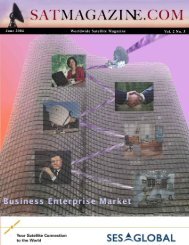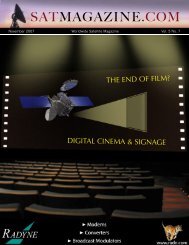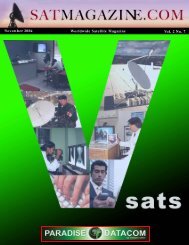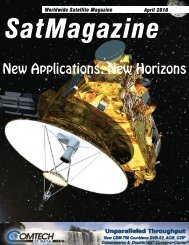Back to Contents - SatMagazine
Back to Contents - SatMagazine
Back to Contents - SatMagazine
- No tags were found...
Create successful ePaper yourself
Turn your PDF publications into a flip-book with our unique Google optimized e-Paper software.
FEATURES<strong>Back</strong> <strong>to</strong> <strong>Contents</strong>26But Tandberg, like one or two otherexhibi<strong>to</strong>rs and conference speakers, isalso looking <strong>to</strong> the future and so-called‘next generation’ compression. This is awholly ‘chicken and egg’ situation thatfurther compression (that is better than<strong>to</strong>day’s H.264/AVC MPEG4) depends onsignificantly improved computerprocessing, as well as footage speciallyshot with – at least – 4K cameras.Japan’s NHK, as ever, is in the forefron<strong>to</strong>f such technology and showed its4000-line plasma <strong>to</strong> seemingly neverendingqueues of visi<strong>to</strong>rs who allemerged eager <strong>to</strong> see more. CurrentlyNHK is using a giant 76kg hand-built4000 line camera <strong>to</strong> capture images, andeven <strong>to</strong>ok the unit down <strong>to</strong> Antarcticalast year <strong>to</strong> see how well the systemfared in <strong>to</strong>ugh conditions. The cameracaptures IMAX-quality images, andindeed, this is where the technologymight well end up, but some folkssuggest that with the right technologyadvances in digital compression it couldend up in our homes.This ‘next big thing’ has alreadybeen dubbed Ultra High Definition(UHTV). Let’s be clear this isn’t going <strong>to</strong>happen <strong>to</strong>morrow, but perhaps in thenext 5-7 years or so, and the engineersare already looking at H.265 <strong>to</strong> providethe technical solutions. Their target –and it may be ambitious – is <strong>to</strong> trim 50%from the current MPEG4 bit-rates. Butbecause 4000 line (or even 2000 line)images need massive amounts of data,this would still be a much fatter ‘pipe’ ofdata in<strong>to</strong> the all-new set-<strong>to</strong>p box, hencethe wait for chip-sets that are significantlymore powerful than those in use<strong>to</strong>day. The NHK demo used a massivebank of computers <strong>to</strong> drive their display,but the end result was breathtaking andcrammed a 32 megapixel display (some 16times more than <strong>to</strong>day’s conventional 2megapixel HD screens).One highly regarded voice from theOc<strong>to</strong>ber 2006SES Global’s new <strong>to</strong>ysIBC saw the presentation of a ‘product of the year’ prize <strong>to</strong> SESAstra’s BluCom technology, which links a set-<strong>to</strong>p box <strong>to</strong> a mobile phone <strong>to</strong>enable improved return path connectivity for broadcasters. BluCom isalready in use in Germany.SES Astra also introduced at IBC a revamped return-path broadbandby-satelliteproduct Astra2Connect, described by CEO Ferd Kayser as afully satellite-based interactive and low-cost broadband Internet access <strong>to</strong>serve the residential market, SMEs and SoHo locations. Astra2Connect canprovide a full satellite-based triple play infrastructure service enablingbroadband internet access, voice-over-IP and other content related accessservices such as IPTV or Video-on-Demand. It is expected <strong>to</strong> be operationalin the first quarter of 2007 and will mainly target homes in Europe andperhaps Africa.Kayser said the technology, costing below •250 at “fac<strong>to</strong>ry gate”prices would bring broadband Internet access <strong>to</strong> everyone - whenever andwherever they might be. “The end-consumers will benefit from an affordableand always-on two-way connectivity,” he said. Astra would not themselvesretail the service, leaving that <strong>to</strong> distribu<strong>to</strong>rs who would add value in the formof marketing, sales and subscriber management. Cus<strong>to</strong>mers could choosebetween three levels of service, each with direct return-path technology, at256kbit/s downstream, 512 kbit/s, or 1024 kbit/s. Astra2Connect is not anopen DVB-RCS standard.European Broadcasting Union, DavidWood, argued that the human eye mightnot take kindly <strong>to</strong> this higher resolutionformat. Indeed, the demo seemed <strong>to</strong>confirm this, in that there was so muchinformation on the display that one wastruly amazed at the detail. Mr Woodsuggests that we would find such detaildistracting. What everyone seems <strong>to</strong>think is more likely, at least in the shortterm, is that the technology will makedigitally projected cinema more realistic,and it’s quite possible that NHK’sbrilliant invention might see use insports stadiums, rock concerts and evenmuseums and galleries all of whom wouldbe able <strong>to</strong> afford the expensive computers.NHK talks about Ultra-HD experimentalbroadcasts around 2015, withconsumer equipment available around2020 and full broadcasting around 2025.But it could be sooner. Us ordinarymortals might have <strong>to</strong> wait the 10 or 20years predicted for the technology <strong>to</strong>appear in our local electrical retailer. Butas Night follows Day, about 10 yearsfrom now, when the same electricalretailer has managed <strong>to</strong> persuade all ofus <strong>to</strong> invest in flat screens then they’llbe looking <strong>to</strong> the ‘next big thing’, andUHTV might well be the answer.There was also at IBC a clear shiftin emphasis on the HD front. To datemost of Europe’s high-def transmissionsSATMAGAZINE.COM










